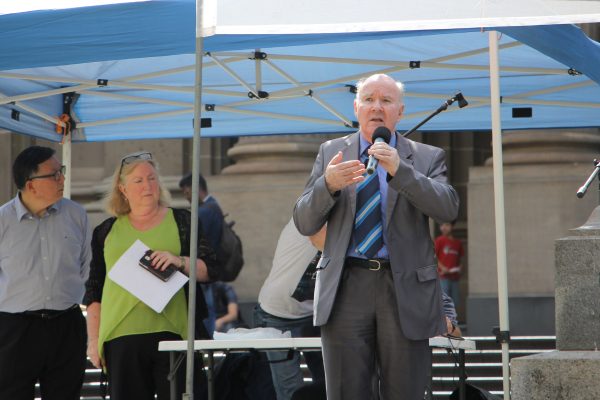
An illustration that shows how China's Tiangong-1 space station will break up and scatter debris. Aerospace Corporation
He said Tiangong-1's landing site in the Pacific Ocean represents "kind of where you hope it would".
Tiangong-1 had not been occupied for three years, so there was no way of knowing for certain where it would land.
The station may have landed north-west of Tahiti, Jonathan McDowell, an astronomer at the Harvard-Smithsonian Centre for Astrophysics, said on Twitter.
Anyone who sees what could be debris from the station known as "Heavenly Place: should not touch it or inhale its fumes, Aerospace Corp. warns".
Ideally, the defunct Chinese station should have been de-orbited in a planned manner, but this was not possible after the loss of command links with the station in 2016.
As Mike Wall writes for Space.com, the U.S. Strategic Command's Joint Force Space Component Command (JFSCC) reported that the prototype space station broke apart and is thought to have largely burned above the southern Pacific Ocean as it re-entered the Earth's atmosphere Sunday at about 8:16 p.m. E.D.T.
According to the China Manned Space Engineering Office there is "no need for people to worry".
Hundreds of schools closed as teachers rally in Oklahoma, Kentucky
Jason Nemes, R-Louisville, voted for SB 151 but said he did not appreciate the legislation's hurried path toward passage Thursday. New hires will have to enter a hybrid cash balance plan, in which members contribute a specified amount into their account.
Police to release name of shooting victim after funeral
It is common for an outside agency to handle the investigation into an officer-involved shooting. The injured officer was taken to the hospital, where he was treated for swelling and bruising.
Arkansas State Police officer, suspect shot on Easter Sunday
Investigators say Elsbeth Kittinger, 49, of Fort Worth, Texas, shot Sheldon when she was asked to get out her pick-up. Five miles further down the road, Kittinger was reportedly met by another officer who opened fire, wouding her.
The fall of Tiangong-1 was monitored by the Inter-Agency Space Debris Coordination Committee, an global group that included NASA, the ESA as well as the space agencies of 11 other nations.
"Everyone thinks they're going to get hit by the Chinese space station". And it described the probability of someone being hit by a piece of debris from Tiangong-1 as "10 million times smaller than the yearly chance of being hit by lightning".
In 1979, the National Aeronautics and Space Administration's (NASA) first space station, Skylab fell to Earth during its re-entry to the atmosphere, burning up harmlessly in the process. It has been used twice to practice how taikonauts, China's term for its astronauts, would dock to a space station.
Within a year after Tiangong had stopped working, China launched a second space lab, Tiangong-2, whose aim is to test capabilities for long-term human presence in space, in anticipation of a permanent space station to be launched in 2023. China lost contact with the station in 2016, so the exact position was unknown.
This TV grab taken on 2 November 2011 shows an animated video clip of the docking of the Tiangong-1 space lab module and the Shenzhou VIII (Shenzhou-8) spacecraft in space. The agency also plans to put a man on the moon and send a mission to Mars, according to CNN.
When space stations come down, "a amusing thing" happens that helps doom the spacecraft, Jesse Gossner, an orbital-mechanics engineer who teaches at the US Air Force's Advanced Space Operations School, previously told Business Insider.
Recommended News
-
Obsolete Chinese space lab set to re-enter earth's atmosphere
The completed 60-ton station is set to come into full service in 2022 and operate for at least a decade. The massive 420-tonne International Space Station is also expected to crash down at Point Nemo in 2024.India deny doping at Commonwealth Games after needles found
Tomorrow afternoon, another batch of Ugandan athletes, flies out to the Gold Coast; a journey lasting more than 20 hours.CW Renews All But One Of Its Comic Book Shows
To no one's surprise, the network's longest-running series, Supernatural , was among the list of renewals. The return of " Black Lightning " was expected given its strong ratings and feedback from fans. -
Philippines begins vote recount for VP
His lawyer, Vic Rodriguez, said Marcos' poll protest is historic because it was the first to have reached the recount stage. He pointed out that audit logs in 38 ballot boxes are very important as they contain the transactions made in a precinct.Supreme Court rejects appeal from Middle East attack victims
Police, who were on the other side of a chain-link fence and so not threatened, shouted at Hughes to drop the knife. A trial judge initially threw out the lawsuit, concluding the officer's use of force was reasonable.China Stresses Capacity to Counter US Protectionism
Soybeans were the top USA agricultural export to China a year ago , worth more than $12 billion. Faced with the prospect of a U.S. -
China's Tiangong-1 space lab plummets to Earth, misses Wisconsin
JFSCC confirmed #Tiangong1 reentered the atmosphere over the southern Pacific Ocean at ~5:16 p.m. (PST) April 1. Most of it should burn up on re-entry, so scientists say it poses only a slight risk to people on the ground.Second death reported in synthetic Canabinoids use
Last year, 102 people in Lancaster County, Pennsylvania, overdosed on synthetic marijuana within three days. During that time, physicians treated 456 patients total for synthetic cannabinoid intoxications.Grindr is under fire for sharing people's HIV statuses with third parties
Grindr insists its sole objective for sharing highly sensitive health information is an effort to better the app. Grindr allows users to list their HIV status and last tested date in their profiles. -
PUBG's New Map, "Savage" Will Go Under Testing Today
Because of the high player count, Codename: Savage will only be available to play as a closed beta for a limited time. We promised you that you would get a chance to try the new map very early on and we are delivering on that promise.Dover police cracking down on distracted driving
Preliminarily, in 2017, there were nearly 50,000 crashes involving distracted driving in Florida. Police all across CT will be out in full force cracking down on distracted driving.(NASDAQ:INTC) Shares Sold by Foster & Motley Inc
The chip maker reported $1.08 earnings per share (EPS) for the quarter, topping the consensus estimate of $0.86 by $0.22. A trend analysis is a method of analysis that allows traders to predict what will happen with a stock in the future.


























